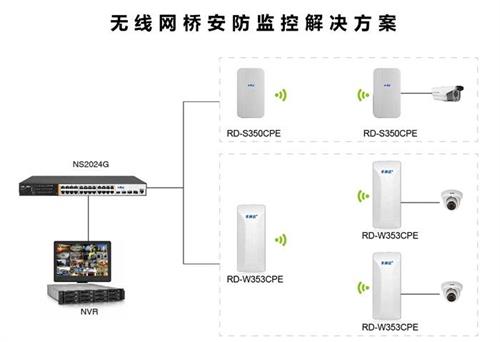Wireless bridge is a kind of wireless transmission equipment widely used in security wireless monitoring. In the entire monitoring system, it plays the role of “transmissionâ€, and transmits monitoring data from the front-end surveillance camera to the back-end monitoring monitor. Without it, there is no wireless monitoring.
When using a wireless bridge to set up a wireless network, there are usually three types of transmission: point-to-point, point-to-multipoint, and relay mode. These three kinds of networking modes have their own characteristics, have their own conditions of use, as well as advantages and disadvantages.
We know that the transmission of data over the air will generate a certain loss during the transmission. This loss occurs in the air. So, what kind of networking mode has the least loss? Since the relay mode is less used, no discussion is made here. Today, the loss of the point-to-point and point-to-multipoint transmission of the wireless bridge is discussed in detail.

1, point to point transmission
This is the simplest way, consisting of a transmitter and a receiver. For this kind of transmission, we consider that the revisit distance can be achieved, and in the absence of the same frequency electromagnetic interference, the most important factor is the distance of transmission. We take the 5.8G wireless bridge as an example. When the point-to-point transmission is 10 kilometers, the loss of the signal transmitted in the free space is: Lbs=108+20lg10=128dB
If the communication rate is to be maintained at 11 Mb/s, the signal level at the receiving end must not be lower than -83 dBm. Assuming that the antenna with the same gain size is used at the transmitter and receiver, we can get the following formula: G(t) + 2G(a) = G(r) + Lbs + Gelse
Where G(t) represents the transmit power, G(r) represents the received power, G(a) represents the antenna gain, and Gelse represents other losses. This includes joint losses, feeder losses, and losses due to other factors. From another perspective It can also be considered as loss redundancy we need to give.
Here we give 15dB loss redundancy and receive power -83dBm, then we get the following relation: G(t) + 2G(a) = 60dBm
In other words, if we select a bridge device with a transmit power of 100mW or 20dBm, the gain of the antenna used must be no less than 20dB for a transmission of 10km. If a 200mW device is used, the gain of the antenna used must not be less than 19dB.
2, point-to-multipoint transmission
This transmission mode is a little more complex and consists of multiple transmitters and one receiver. In this mode of transmission, in addition to considering the factors in the above peer-to-peer transmission, there are also considerations of the point-to-multipoint transmission capability of the center node, the ability of the edge nodes to receive signals, and the requirement of the edge nodes for the bandwidth.
Let's consider a 5.8G bridge as an example. Consider a point-to-two solution. The center node is separated from the two edge nodes by 8 km and 6 km respectively. The center node divides the two signals using the power splitter to connect two antennas respectively. . According to the above formula, we can get the loss formula of two edge nodes: G(t)+2G(a)=G(r)+Lbs+Gelse
Considering the introduction of power splitters, new losses have also been introduced. The loss of one-to-two power splitters is generally 3.5 dB, so we need to adjust the value of the Gelse to 20 dB. The elevator wireless monitoring solution will also be used to transmit power. The two nodes are evenly divided.
For the first node (8 km): we get G(t1)+2G(a1)=63dBm
For a bridge device with a transmission power of 100mW or 20dBm, the power splitter is changed to 50mW or 17dBm, and the gain of the antenna used cannot be lower than 23dB. If a 200mW device is used, the gain of the antenna used must not be less than 21.5dB.
From the above we can know that the loss of point-to-multipoint transmission is greater than the loss of point-to-point transmission. Therefore, it is generally desirable to use long-distance transmission, or if the surveillance camera is relatively decentralized, point-to-point transmission is preferred. If the transmission distance is not far, and the monitoring points are relatively concentrated, you can consider point-to-multipoint transmission.
Crane Accessories,Crane Track Rail,Overhead Crane Rail,Gantry Crane Rail
Henan Weihua Heavy Machinery Co., Ltd. , https://www.hoistcrane.nl